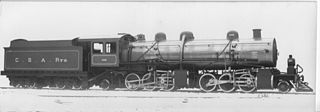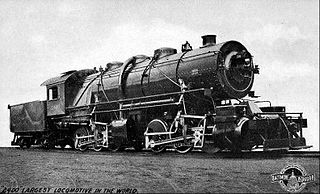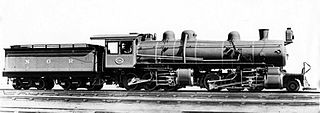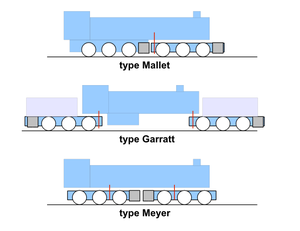
A steam locomotive is a locomotive that provides the force to move itself and other vehicles by means of the expansion of steam. It is fuelled by burning combustible material to heat water in the locomotive's boiler to the point where it becomes gaseous and its volume increases 1,700 times. Functionally, it is a steam engine on wheels.

The Mallet locomotive is a type of articulated steam railway locomotive, invented by the Swiss engineer Anatole Mallet (1837–1919).

A Fairlie is a type of articulated steam locomotive that has the driving wheels on bogies. The locomotive may be double-ended or single ended. Fairlies are most famously associated with the Ffestiniog Railway in North Wales.

A Garratt locomotive is a type of steam locomotive invented by British engineer Herbert William Garratt that is articulated into three parts. Its boiler, firebox, and cab are mounted on a centre frame or "bridge". The two other parts, one at each end, have a pivot to support the central frame; they consist of a steam engine unit – with driving wheels, trailing wheels, valve gear, and cylinders, and above it, fuel and/or water storage.
A 2-8-8-2, in the Whyte notation for describing steam locomotive wheel arrangements, is an articulated locomotive with a two-wheel leading truck, two sets of eight driving wheels, and a two-wheel trailing truck. The equivalent UIC classification is, refined to Mallet locomotives, (1'D)D1'. These locomotives usually employ the Mallet principles of articulation—with the rear engine rigidly attached to the boiler and the front engine free to rotate—and compounding. The 2-8-8-2 was a design largely limited to American locomotive builders. The last 2-8-8-2 was retired in 1962 from the N&W's roster, two years past the ending of steam though steam was still used on steel mill lines and other railroads until 1983.

Under the Whyte notation for the classification of steam locomotives, a 4-8-8-2 is a locomotive with four leading wheels, two sets of eight driving wheels, and a two-wheel trailing truck.

Under the Whyte notation for the classification of steam locomotives by wheel arrangement, a 2-6-6-2 is a locomotive with one pair of unpowered leading wheels, followed by two sets of three pairs of powered driving wheels and one pair of trailing wheels. The wheel arrangement was principally used on Mallet-type articulated locomotives, although some tank locomotive examples were also built. A Garratt locomotive with the same wheel arrangement is designated 2-6-0+0-6-2.

Under the Whyte notation for the classification of steam locomotives, a 0-6-6-0 wheel arrangement refers to a locomotive with two engine units mounted under a rigid locomotive frame, with the front engine unit pivoting and each engine unit with six coupled driving wheels without any leading or trailing wheels. The wheel arrangement was mostly used to describe Mallet locomotive types.
A Meyer locomotive is a type of articulated locomotive. The design was never as popular as the Garratt or Mallet locomotives. It can be best regarded as 19th Century competition for the early compound Mallet and also the Fairlie articulated designs. Most single cab modern trains are of a similar design such as power cars, freight diesel locomotives, and some passenger locomotives.

Under the Whyte notation for the classification of steam locomotives by wheel arrangement, a 4-6-2+2-6-4 is a Garratt or Union Garratt articulated locomotive using a pair of 4-6-2 engine units back to back, with the boiler and cab suspended between them. The 4-6-2 wheel arrangement of each engine unit has four leading wheels on two axles, usually in a leading bogie, six powered and coupled driving wheels on three axles, and two trailing wheels on one axle, usually in a trailing truck. Since the 4-6-2 type is known as a Pacific, the corresponding Garratt type is usually known as a Double Pacific.

Under the Whyte notation for the classification of steam locomotives by wheel arrangement, the 0-4-0+0-4-0 is an articulated locomotive of the Garratt type. The wheel arrangement is effectively two 0-4-0 locomotives operating back-to-back or face-to-face, with the boiler and cab suspended between the two power units. Each power unit has no leading wheels, four powered and coupled driving wheels on two axles and no trailing wheels. A similar arrangement exists for Mallet and Meyer locomotives, but is referred to as 0-4-4-0.

Under the Whyte notation for the classification of steam locomotives, 0-6-0+0-6-0 represents the wheel arrangement of an articulated locomotive with two separate swivelling engine units, each unit with no leading wheels, six powered and coupled driving wheels on three axles and no trailing wheels. The arrangement is effectively two 0-6-0 locomotives operating back-to-back and was used on Garratt, Double Fairlie, Meyer and Kitson-Meyer articulated locomotives. A similar arrangement exists for Mallet steam locomotives on which only the front engine unit swivels, but these are referred to as 0-6-6-0.
A compound locomotive is a steam locomotive which is powered by a compound engine, a type of steam engine where steam is expanded in two or more stages. The locomotive was only one application of compounding. Two and three stages were used in ships, for example.

A triplex locomotive is a steam locomotive that divides the driving force on its wheels by using three pairs of cylinders powering three sets of driving wheels. Inevitably any such locomotive will be articulated. All the examples that have been produced were of the Mallet type but with one extra set of driving wheels under the tender.

The South African Railways Class MA 2-6-6-0 of 1909 was a steam locomotive from the pre-Union era in the Natal Colony.

The South African Railways Class MB 2-6-6-0 of 1910 was a steam locomotive from the pre-Union era in the Colony of Natal.

The South African Railways Class MD 2-6-6-2 of 1910 was a steam locomotive from the pre-Union era in Transvaal.
The South African Railways Class ME 2-6-6-2 of 1912 was a steam locomotive.

The South African Railways Class FC 2-6-2+2-6-2 of 1925 was an articulated steam locomotive.
The South African Railways Class GA 2-6-0+0-6-2 of 1921 was an articulated steam locomotive.















